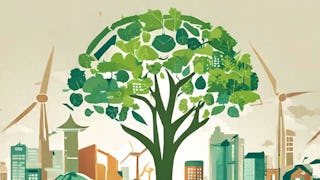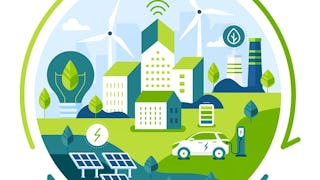Applied Sustainability Engineering, the second course in the "Applied Sustainability for Technical Managers" specialization discusses the techniques used by engineers and scientists to develop and assess the environmental impact of products and processes required to make those products. It begins with a discussion of different renewable energy technologies and their economics – highlighting how continued reductions in cost have made wind and solar power the least expensive way to generate electricity. It then addresses carbon footprints and how they are determined, applying a practical example where you determine your residential and transportation carbon footprints. From there, the course transitions to defining sustainable and circular products and packaging and showcasing several examples. As Technical Managers, you’ll need metrics for determining whether a product is truly sustainable, so the course introduces techniques such as Life Cycle Assessment (LCA), Streamlined LCA (S-LCA), and the Eco-Audit methodologies. The course concludes with an overview of sustainable product design frameworks, including Cradle-to-Cradle, Design for the Circular Economy, and Biomimicry, just to name a few.


Applied Sustainability Engineering
3,155 人已注册
包含在 中
您将学到什么
Learn how to complete a carbon footprint analysis, analogous to conducting a Scope 1 and Scope 2 emissions analysis.
Recognize the characteristics that define a sustainable product and the packaging it comes in.
Understand wind, solar and hydropower and how these technologies generate electricity.
Apply LCA, SLCA and Eco-Audit techniques to design a product that meets specific sustainability certification standards.
您将获得的技能
- Environmental Management Systems
- Sustainable Development
- Emerging Technologies
- Strategic Leadership
- Corporate Sustainability
- Environmental Engineering
- Sustainable Business
- Sustainable Engineering
- Climate Change Mitigation
- Product Lifecycle Management
- Sustainable Technologies
- Waste Minimization
- Energy and Utilities
- Sustainable Design
- Packaging and Labeling
- Product Engineering
要了解的详细信息

添加到您的领英档案
16 项作业
了解顶级公司的员工如何掌握热门技能

积累特定领域的专业知识
- 向行业专家学习新概念
- 获得对主题或工具的基础理解
- 通过实践项目培养工作相关技能
- 获得可共享的职业证书

该课程共有5个模块
Welcome to Applied Sustainability Engineering! This first module introduces the course and how it operates. Then, it is all about renewable energy (RE); the different technologies and economics associated with them. We begin with a discussion of hydropower, the largest global source of renewable energy. You'll then learn about the second most abundant and cost effective type: onshore and offshore wind power. After, we'll discuss solar power and you'll learn the terminology behind its operations, physics, and economics. A future with renewable energy requires energy storage, so its important to discuss topics of pumped hydro, battery technologies, and hydrogen, as well as the emerging technologies, such as wave and tidal power, concentrated solar, geothermal and hydrogen fuel cells. The module concludes with an overview of how the world is transitioning to renewable energies in an effort to limit global warming to only 1.5o Celsius, which is the newest target established by the International Panel on Climate Change.
涵盖的内容
12个视频3篇阅读材料4个作业1个讨论话题
This module is all about bringing the effect of carbon production home, so to speak, by determining your own carbon footprints based on personal energy use. Note that the method for calculating one's carbon footprint is similar to calculating Scope 1 and 2 emissions for a business (as part of the Greenhouse Gas Protocol.) After an initial exercise of calculating your personal transportation carbon footprint, we turn our attention to the residential footprint. First, you'll uncover the standard utility bill; what's on it and what it all means. Then, you'll be introduced to, and apply, the EPA (US Environmental Protection Agency)'s eGrid website to determine the Carbon Emissions Factor and mix of power generation technologies for your area. Next, you'll calculate a CO2-equivalent footprint, based on the EPA's emission factors for methane, nitrous oxide, natural gas, and propane. The module concludes with an example of a typical U.S. college student's residential carbon footprint. Then, you'll see how it compares to other countries as well as your own!
涵盖的内容
11个视频2次同伴评审
The module is all about sustainable products and packaging. We introduce the concept that sustainable products are true differentiators in the market and highlight several well-known examples. You'll learn what constitutes a sustainable product in terms of the circular economy's butterfly diagram: safe materials, long-life, ease of repair and maintenance, and ease of disassembly for ultimate recycling. We then shift to sustainable packaging, starting with understanding the significant challenge associated with packaging waste. We end the module with an overview of why packaging exists, and some ways of making it more sustainable. This week, you'll also gain awareness of your own packaging consumption as you undergo the 7-day plastics challenge and share your experience with peers. We can't wait to hear what you learn from it!
涵盖的内容
5个视频2篇阅读材料4个作业1次同伴评审1个讨论话题
This module introduces the topic of life cycle assessments or LCA's. You will learn how to establish system boundaries, define functional units, and know where to look for environmental impact data. More importantly, you'll think critically about conflicting paradigms, such as product designs that could good from a greenhouse gas perspective but are detrimental from an eco-toxicity view. While you may not become a full LCA specialist by the end of this module, you can begin to appreciate the complexity and cost of conducting a full LCA, which is why the Streamlined LCA was designed. It simplifies the process at the expense of accuracy, yet it still provides guidance to product and process designs to reduce environmental impact. You'll be able to practice this hands on, when you conduct an SLCA on gold wedding rings. Finally, you'll learn one last tool for environmental impact analysis: the Eco-Audit. Eco-Audits are particularly important in analyzing the impact of materials and understanding the concept of embodied energy.
涵盖的内容
8个视频1篇阅读材料4个作业1次同伴评审1个讨论话题
Congratulations on almost completing the course! This final module outlines the specific tools and frameworks used to design, engineer, and manufacture sustainable and circular products along with the packaging that protects them. As a useful and pragmatic framework, we discuss the Cradle-to-Cradle (C2C) design methodology in some detail, showing how the C2C's Certification process is analogous the the LEED standards for the built environment. We'll also touch on other approaches to sustainable product design with the frameworks of Biomimicry and The Natural Step. You've almost come full circle, and we hope you've enjoyed this course!
涵盖的内容
7个视频1篇阅读材料4个作业
获得职业证书
将此证书添加到您的 LinkedIn 个人资料、简历或履历中。在社交媒体和绩效考核中分享。
攻读学位
课程 是 University of Colorado Boulder提供的以下学位课程的一部分。如果您被录取并注册,您已完成的课程可计入您的学位学习,您的学习进度也可随之转移。
位教师

从 Environmental Science and Sustainability 浏览更多内容

University of Colorado Boulder

University of Colorado Boulder
人们为什么选择 Coursera 来帮助自己实现职业发展




学生评论
50 条评论
- 5 stars
70%
- 4 stars
24%
- 3 stars
2%
- 2 stars
0%
- 1 star
4%
显示 3/50 个
已于 Nov 13, 2025审阅
Great course to learn an overview of Sustainability
已于 Feb 17, 2025审阅
The material and istructor is good but the display monitor not Clear needed more justification.
已于 Oct 8, 2024审阅
Good content, well organized, very helpful for anybody that needs to start working in Sustainablity and does not know where to start!
常见问题
To access the course materials, assignments and to earn a Certificate, you will need to purchase the Certificate experience when you enroll in a course. You can try a Free Trial instead, or apply for Financial Aid. The course may offer 'Full Course, No Certificate' instead. This option lets you see all course materials, submit required assessments, and get a final grade. This also means that you will not be able to purchase a Certificate experience.
When you enroll in the course, you get access to all of the courses in the Specialization, and you earn a certificate when you complete the work. Your electronic Certificate will be added to your Accomplishments page - from there, you can print your Certificate or add it to your LinkedIn profile.
Yes. In select learning programs, you can apply for financial aid or a scholarship if you can’t afford the enrollment fee. If fin aid or scholarship is available for your learning program selection, you’ll find a link to apply on the description page.
更多问题
提供助学金,






